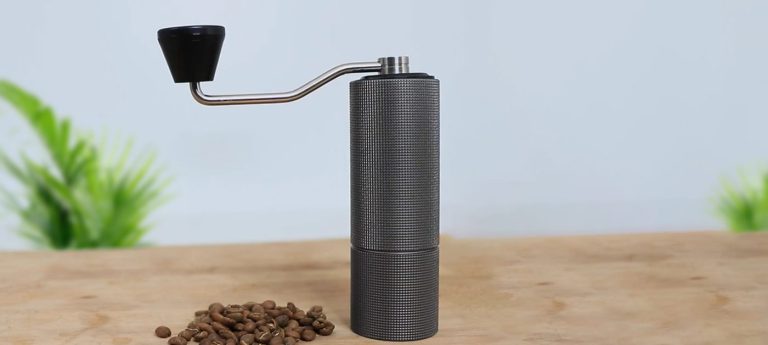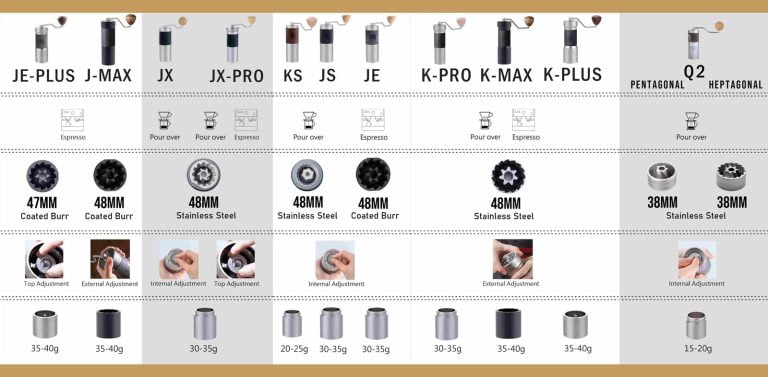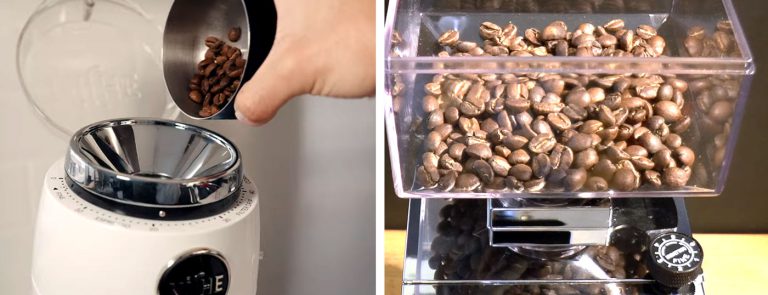Conical vs Flat Burr Grinders – The Battle For The Perfect Cup of Coffee
There is a new-age battle between conical and flat burr grinders — each vying for your attention when brewing the perfect cup of coffee.
But which is better?
As an avid home barista, I know the importance of having the right tools to achieve my desired results. In this case, I’m here to weigh in on this debate and reveal:
- Which is more consistent?
- Which is easier to maintain?
- Which offers the better value?
So let’s get started!
What are conical & flat burr coffee grinders?
Both conical and flat burr coffee grinders use two grinding plates with serrated teeth moving against each other to pulverize whole coffee beans into a powder-like size.
There are 2 types of burr coffee grinders:
- Flat burr grinders – a flat grinder made up of two burrs (ring-shaped) mounted parallel to each other with razor-sharp teeth that spin against each other. Once coffee beans enter one burr, they are forced through the outside edge with the other.
- Conical burr grinders -have a cone-shaped inner burr that’s spinning and a stationary outer burr that looks like a thick ring. As the burr spins, the edges pull the beans into the grinding area.
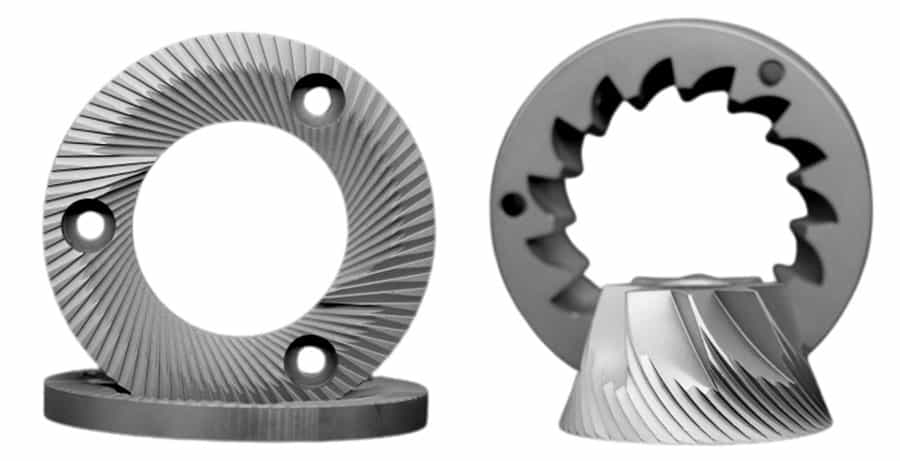
Burr grinders are considered better than blade grinders.
What is burr seasoning and do I need it?
Burr seasoning is a practice among coffee enthusiasts where you ground a few pounds of cheap coffee with your newly-bought coffee grinder.
The idea here is that since these grinders have a brand new set of burrs, they have an extra sharpness that will remain for several grinding sessions before they dull into the standard sharpness of the grinder. Seasoning will speed up this process, allowing you to get straight to the actual performance of your grinder and make the necessary adjustments for your brew.
Do you need to do this though?
Many manufacturers today already polish the edges of their burrs, so you’ll no longer need to season them. However, if you’re using a new burr grinder and have used a similar grinder but you’re struggling with performance and consistency, then seasoning its burrs can help.
Differences Explained and Compared
While both grinders are reliable and create high-quality grinds, there are features between the two that you should be aware of before deciding which burr grinder is best for you.
| Conical Burr | Flat Burr | |
|---|---|---|
| Grind Particle Size | Bimodal | Unimodal |
| Grind Consistency | Subtle Inconsistency | Even Consistency |
| Retention | Low | High |
| Heat Generation | Low | High |
| Noise | Low | High |
| Taste | Textured | Smooth |
| Convenience | Low Maintenance | High Maintenance |
Grind Consistency
Both flat and conical burrs can be used for drip coffee machines and french presses, but they differ in espresso brewing. This is where grind consistency comes in.
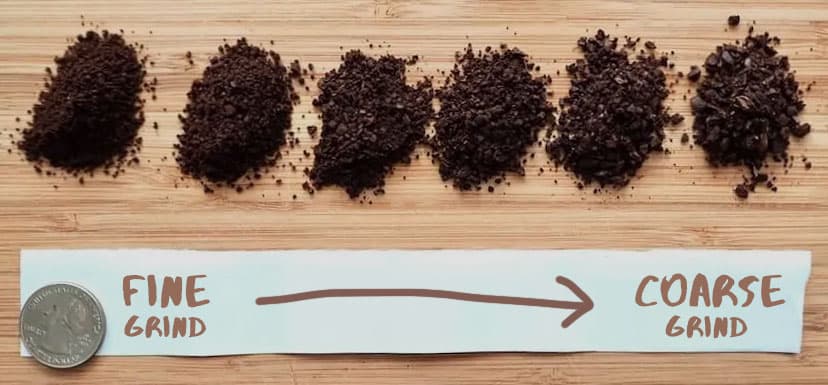
A coffee grind with consistent particle sizes is easier to work with than inconsistent ones since it’s easier to modify and tamp if we’re making espressos. This will prevent our brew from being over-extracted or under-extracted.
The flavor will also be much easier to predict since we’ll work with all the coffee particles extracted simultaneously.
- From the coarsest setting to the finest grind size, conical burrs produce two particle sizes: large and small. This is also known as a bimodal grind, where the large particles have more time to soak and extract thanks to the smaller particles restricting water flow.
- On the other hand, flat burrs produce a consistent and even particle size, meaning that all the grounds are highly uniform in size. This is known as a unimodal grind. Flat burrs are generally more expensive than conical burrs because of this feature.
It’s not that big of a difference in taste though, I think conical burrs do a good enough job for the everyday home barista. The consistency a flat burr grinder adds to espresso is important at coffee competitions.
For more information about the correct grind sizes, you can look at this visual chart here.
Retention
Grind retention is measured by how much old coffee grounds are stuck inside the grinder. Coffee beans can typically get stuck in the grinding chamber, chute, or between the bits and pieces of the grinder.

Coffee retention can result in the following:
- Inconsistent coffee weight, which may alter your espresso extraction.
- Contamination by mixing stale grounds with fresh ones.
Flat burrs are notorious for high retention because the coffee grounds are pushed sideways out of the burrs with the help of their motor.
Because flat burrs are often mounted horizontally, there is no help from gravity to push out the coffee grinds, which leads to some getting stuck in between the teeth of the burrs.
Conical grinders, on the other hand, have lower retention because they require less mechanical force due to gravity pulling grinds down in the vertically mounted grinder. This results in fewer grinds stuck in both the chamber and teeth of the burr.
Heat Generation
Heat can have a negative effect on the overall roast and grind consistency of your beans, so the heat produced by the friction of your grinder is a significant factor.
This is most evident in grinder in flat burr grinders. Flat burrs need a lot of force to crush and expel the beans from the burrs, typically requiring a high-RPM motor to do the heavy lifting.
However, some high-end grinders come with a built-in cooling system like a fan or a heat sink to cool the grinder as it runs, but this feature significantly hikes up the grinder’s price point. This puts it at a disadvantage vs conical grinders, and in my opinion, is not worth it.
On the other hand, this is rarely an issue in conical burrs because they typically use lower RPM motors. These grinders feed and dispense the beans with the help of gravity, resulting in less stress on the motor, and less heat.
Noise Level
Since electric coffee grinders tend to be noisy, people may not mind if they hear them in their local coffee shops. However, many people don’t appreciate hearing their coffee grinder flood the kitchen, which brings us to each grinder’s noise level.
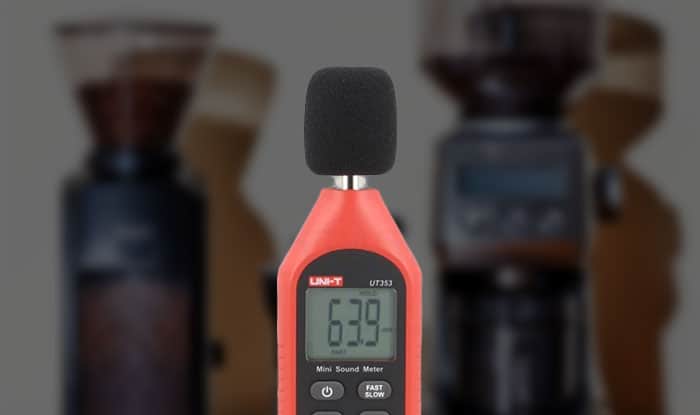
In general, most flat burrs use a higher-RPM motor, which makes them louder than conical burrs, which use a lower-RPM motor.
Furthermore, the noise generated by these grinders can vary depending on the following:
- the grinder’s build quality
- burr shape
- the motor’s RPM
- the grinder’s overall design
- the countertop material it’s resting on
If you’d like to further dampen the loudness of your grinder, here’s what you can do to reduce that noise:
- Place the grinder on a sound-dampening mat
- Fit rubber grommets to the feet of the grinder
- Avoid placing it near a wall since walls can reflect sound

Taste and Texture
Most coffee drinkers are unlikely to notice subtle taste differences unless they have sampled both burr grinders.
Bimodal grinds tend to have more thickness and texture; coffees from this grind usually taste fruity and acidic.
On the other hand, some people prefer flat burrs for making espresso shots since unimodal grinds tend to create a smoother shot that brings out the darker flavor profiles.
Conical or Flat: Which Burr Grinder is Better?
When choosing between a conical or flat burr grinder, remember that burrs are essential, but they’re not the only thing that determines the quality of your grinder.
It would be best if you also considered the consistency and cost of each option.
It’s also important to consider factors such as:
- Build quality – flat burrs tend to be more consistent but expensive, while conical burrs are more cost-efficient but may not have as consistent grinds.
- Purpose – are you setting up a coffee shop where you want to focus on specialty coffees, or are you an early riser looking for a grinder that won’t wake up half the neighborhood every time you crave morning coffee at home?
- Availability of replacements – ensuring that the grinder has a warranty and that the manufacturer/ seller can provide replacements or repairs.
Since conical burrs are more popular, it is easier to find parts for them when it breaks down.
Flat burr grinders may require more maintenance. Since they heat up quickly because of their higher-RPM motor, it may require more adjustments and a good ventilation system setup. - Easy Maintenance – ensuring the grinder is easy to clean and maintain, with instructions available to keep it running smoothly.
Once you find yourself answering these questions, you’ll be able to pick a choice that will perfectly suit your situation.
Summary
There are two types of burr coffee grinders: conical and flat burrs, and they’re both great.
When looking at the difference between conical and flat burr grinders, they have subtle differences only baristas and professional coffee geeks will notice.
It all just comes down to how you are going to use it.
If you want an economical, no-nonsense grinder ready to whip you up quality grinds first thing in the morning, then conical burr grinders are your best bet. That’s what I use at home as well.
However, if you’re passionate and plan on elevating your coffee taste buds to the next level, then flat burrs will help you a lot on that journey.
And if this article convinced you, I guarantee you’ll never grind coffee with a blade grinder in your life again. 😉




